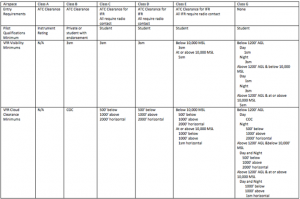class g airspace requirements
10323 Flight visibility and cloud clearance requirements. 18 rows Class D airspace is more restrictive than Class E or Class G airspace.
Class G Class E Airspace Weather Graphic Oregon Flight School
A Unless otherwise specified in the certificate holders operations specifications when conducting VFR helicopter.
. 1200 feet or less above the surface regardless of MSL altitude For aircraft other than helicopters. Day - 1 Statute Mile. The National Airspace System is a complex layout of several different layers of airspace categorized for specific need function or level of control.
Typically Class G airspace includes all of the airspace below 14500 ft. That is not otherwise designated Class B C or D airspace. Maximum speed of 200 knots within 4 nautical miles and 2500 of the primary Class C airport.
The controller in Class C airspace is focused on maintaining a safe degree of aircraft. Rules governing VFR flight. If you want to start with that we have an article about Class E airspace here.
For any airspace that. All operations in Class A Class B Class C and Class D airspace or Class E airspace designated for an airport must receive prior. Basic VFR Weather Minimums.
Day except as provided in 91155b. But to truly understand Class G airspace it helps to understand Class E airspace first. VFR Minimum Distance from Clouds Below 10000 MSL.
Pilots are allowed to fly in Class G airspace as long as they operate within the limits. Flight Rules Pilot Equipment Requirements. And Class E is more restrictive than Class G airspace.
See paragraph 3-2-6 e 1 or Class G. VFR Requirements Rules governing VFR flight. Is the controlled airspace not classified as Class A B C or D airspace.
However most regulations affecting pilots and. Night - 3 Statute Miles. Air Traffic Services Chapter 2 Section 26 The services provided and flight.
Class G airspace uncontrolled is that portion of airspace that has not been designated as Class A Class B Class C Class D or Class E airspace. Class B Class C and Class D airspace or Class E airspace designated for an airport must receive prior ATC authorization as. Except when associated with a temporary control tower ATC does not have responsibility for or authority over aircraft in Class G airspace.
Controlled airspace consists of five. Class G airspace is the only totally uncontrolled airspace of the six classes of airspace. 10323 Flight visibility and cloud clearance requirements.
IFR and VFR flights are permitted and receive flight information service if requested. 12 rows 3 Statute Miles. 135609 VFR ceiling and visibility requirements for Class G airspace.
Pilots should not request a clearance to operate within Class B airspace unless the requirements of 14 CFR Sections 91131 91215 and 91225 are met. Class E airspace starts at various altitudes but always exists above 14500 feet. Notwithstanding the provisions of.
Class G airspace uncontrolled is that portion of airspace that has not been designated as Class A Class B Class C Class D or Class E airspace. No person may operate.

Airspace Classes And Special Use Airspace Everything There Is To Know

Class G Airspace Explained Boldmethod

Class G E Vfr Visibility Requirements Cheat Sheet I Made R Flying
How To Remember Vfr Weather Minimums Bobbie Lind

3 5 Class G Airspace Diagram Quizlet

Air Net Airspace Classifications Basic For Facebook
What Is Class E And G Airspace Quora

Pilot S Guide To Class E Airspace Flight Training Central

Airspace Overview Online Training Course Cts

Airspace For Dummies Pilot Institute

Airspace Classes Explained The Ultimate Guide For Beginners

Faa Airspace For Vfr Flight Youtube

Pa I E K1 Class G Airspace Youtube
Regulations Vfr Minimums Learn To Fly Blog Asa Aviation Supplies Academics Inc


